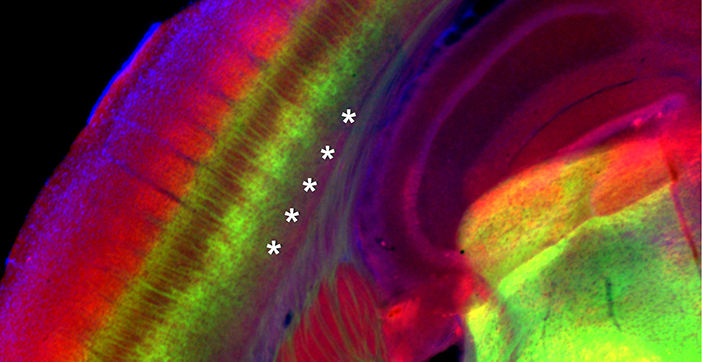Discovery of circuits in cortex of mice deepens understanding of brain’s sensory circuitry.
Because they provide an exemplary physiological model of how the mammalian brain receives sensory information, neural structures called “mouse whisker barrels” have been the subject of study by neuroscientists around the world for nearly 50 years. A new study shows that despite all that prior scrutiny, significant discoveries remain to be made. Specifically, researchers at Brown University have found a previously unknown set of matching barrel structures two layers deeper into the cortex than the whisker barrels, providing a more complete picture of the circuitry involved in handling sensory information.
While humans don’t use whiskers to perceive their surroundings, the new findings, published in the journal Cell Reports, still serve to deepen scientists’ understanding of how two brain regions—the cortex, which processes information, and the thalamus, which feeds that information to the cortex—communicate, says study senior author Barry Connors, PhD, a professor of neuroscience and of medical science. The barrels discovered in 1970 in the fourth layer of the cortex were presumed to handle much of this cross-talk, and while that may still be true, the finding of parallel “infrabarrels” in the sixth layer suggests that the layer closest to the thalamus may play a greater role than previously realized.
“There is a good chance that these infrabarrels reveal a kind of circuit architecture that wasn’t appreciated before,” Connors says.
It’s vital to understand these circuits given how important cortex-governed behaviors such as sensory processing and attention are, adds lead author Shane Crandall, PhD, a former Brown postdoctoral scholar who is now an assistant professor at Michigan State University. This has proved difficult—even in the well-studied whisker barrel system—because of the immense diversity of cells in cortical layers.
“Our study focused on the deepest and perhaps the most mysterious layer of the neocortex, layer six,” Crandall says. “Our results reveal discrete neocortical circuit modules specialized for linking long-distance inputs with specific outputs, thus providing a framework for understanding the functional organization of layer six.”
What makes the brain science behind mouse whiskers so compelling to scientists is that it is so well organized, Connors says. Each whisker connects into a distinct circuit that can be cleanly traced through the brainstem, into the thalamus, and into an exact mapping in which each barrel in layer four corresponds to single whisker. But more generally in humans and mice alike, there is a map of neurons in the cortex for sensations from all over the body. The cells in the somatosensory cortex that process touch in a person’s right pinky, for example, are specific and different than the cells that process sensation in the left elbow. Meanwhile, just as these cells take in information from the thalamus, many more cells send messages from the cortex back to the thalamus, Connors says, perhaps to manage the cortex’s attention to all this incoming sensory information.
“The cortex is not only receiving information about the world through the thalamus, it is also regulating the information it receives,” he says. “The brain is constantly making decisions about what kind of information to pay attention to and what not to pay attention to.”
Continue reading here.




